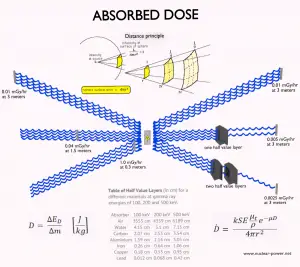The dose is defined as the amount of energy deposited by ionizing radiation in a substance. For a given radiation field, the absorbed dose will depend on the type of matter which absorbs the radiation. Although many possible interactions are known, there are three key interaction mechanisms of gamma rays with matter.
For instance, for an exposure of 1 roentgen by gamma rays with an energy of 1 MeV, the dose in the air will be 0.876 rad. This can be determined using the ionization energy of dry air at 20 °C and 101.325 kPa of pressure, which is 33.97 J/C. Therefore, an exposure of 2.58×10−4 C/kg (1 roentgen) would deposit an absorbed dose of 8.76×10−3 J/kg (0.876 rad) in dry air under those conditions. A table giving the exposure to dose conversion for various materials for various gamma-ray energies can be found in the literature.
What is Exposure
Radiation exposure is a measure of the ionization of air due to ionizing radiation from high-energy photons (i.e., X-rays and gamma rays). Radiation exposure is defined as the sum of electrical charges (∆q) on all the ions of one sign produced in the air when all the electrons, liberated by photons in a volume of air whose mass is ∆m, are completely stopped in the air.
Radiation exposure is given the symbol X. The SI unit of radiation exposure is the coulomb per kilogram (C/kg), but in practice, the roentgen is used.
What is Absorbed Dose
Absorbed dose is defined as the amount of energy deposited by ionizing radiation in a substance. The absorbed dose is given the symbol D. The absorbed dose is usually measured in a unit called the gray (Gy), derived from the SI system. The non-SI unit rad is sometimes also used, predominantly in the USA.
Units of absorbed dose:
- Gray. A dose of one gray is equivalent to a unit of energy (joule) deposited in a kilogram of a substance.
- RAD. A dose of one rad is equivalent to depositing one hundred ergs of energy in one gram of any material.


